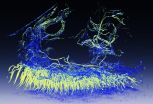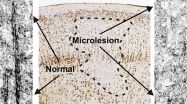(Press-News.org) Treating bacterial infections with antibiotics is becoming increasingly difficult as bacteria develop resistance not only to the antibiotics being used against them, but also to ones they have never encountered before. By analyzing genetic and phenotypic changes in antibiotic-resistant strains of E. coli, researchers at the RIKEN Quantitative Biology Center (QBiC) in Japan have revealed a common set of features that appear to be responsible for the development of resistance to several types of antibiotics.
The study published in Nature Communications shows that resistance emerges through mutations that converge on similar physical changes in the bacteria. Quantifying these changes by measuring the expression of a small number of genes can be useful in predicting a bacteria's response to a given antibiotic, and knowing which genes are important may contribute to the development of new ways to prevent resistance.
To perform this complex genetic and phenotypic analysis, Shingo Suzuki, Takaaki Horinouchi, and Chikara Furusawa first used a technique called laboratory evolution to create 44 strains of E. coli, each resistant to one of 11 different antibiotics. Then they examined how each of these resistant strains responded to 25 antibiotics they had never encountered. The tests showed that most strains had developed resistance to several of the 25--a phenomenon called cross-resistance--even when these antibiotics worked differently from the one used to generate the resistance. The team also found that in the case of two classes of antibiotics, cross-susceptibility developed--bacteria that become resistant to one type became more vulnerable to the other.
The researchers reasoned that similar alterations in gene expression might be one cause of cross-resistance. To test this hypothesis, they identified the changes in gene expression for each of the resistant strains using microarray analysis. Then, they combined this information with the resistance, cross-resistance, and cross-susceptibility data from some strains to make a simple linear model that did a very good job predicting the resistance and susceptibility patterns of the remaining strains. Furusawa notes that, "these high-precision predictions were possible using a small number of genes, making this a powerful way to describe a bacteria's phenotype and its expected response to antibiotics."
The researchers also looked for fixed mutations that might link the development of resistance across antibiotics. For example, they found that almost all strains had fixed mutations affecting a particular multidrug efflux pump--a pump that bacteria use to expel unwanted molecules. However, one of the main findings was that although the bacteria showed similar changes in expression patterns, these often resulted from different changes in the genome, and frequently from a combination of several different mutations. Furusawa speculates that, "this type of convergent evolution may be a key factor that drives the development of antibiotic resistance."
The cross-susceptible classes of antibiotics were found to have gene expressions and fixed mutations that did not overlap at all. Strains resistant to aminoglycoside antibiotics, for example, showed mutations and down-regulation of genes that while effective in blocking aminoglycoside antibiotics, also resulted in less effective multidrug efflux pumps. This explains why these strains became more susceptible to all the other antibiotics--the bacteria could not send them out of their cells.
Understanding the common factors that result in antibiotic resistance could help combat this growing problem. As Furusawa reflects, "by making it possible to quantitatively determine what genes contribute to the development of antibiotic resistance, this research could lead to new methods for blocking acquisition of resistance and to the development of new antibiotic compounds."
INFORMATION:
Fireflies used rapid light flashes to communicate. This "bioluminescence" is an intriguing phenomenon that has many potential applications, from drug testing and monitoring water contamination, and even lighting up streets using glow-in-dark trees and plants. Fireflies emit light when a compound called luciferin breaks down. We know that this reaction needs oxygen, but what we don't know is how fireflies actually supply oxygen to their light-emitting cells. Using state-of-the-art imaging techniques, scientists from Switzerland and Taiwan have determined how fireflies control ...
This news release is available in French. This news release is available in French.
People with a severe mental disorder who commit a crime and who are incarcerated have different characteristics compared to people who are hospitalized after committing an offence. These are the findings of a study by researchers at the Institut universitaire en santé mentale de Montréal (IUSMM) and the Institut Philippe-Pinel de Montréal (IPPM), affiliated with the University of Montreal.
"We found a clear difference between people with a mental illness who are ...
Cancer Research UK scientists have shown that loss of a gene called PTEN triggers some cases of an aggressive form of ovarian cancer, called high-grade serous ovarian cancer, according to a study published in Genome Biology today (Wednesday)*.
In a revolutionary approach the researchers from the Cancer Research UK Cambridge Institute made the discovery by combining images from cancer samples with genetic data. They proved conclusively that loss of PTEN was commonly found only in the cancerous cells and not the 'normal' cells that help make up the tumour mass.
PTEN ...
Using an innovative technique combining genetic analysis and mathematical modeling with some basic sleuthing, researchers have identified previously undescribed microlesions in brain tissue from epileptic patients. The millimeter-sized abnormalities may explain why areas of the brain that appear normal can produce severe seizures in many children and adults with epilepsy.
The findings, by researchers at the University of Illinois at Chicago College of Medicine, Wayne State University and Montana State University, are reported in the journal Brain.
Epilepsy affects about ...
The deep sea is becoming a collecting ground for plastic waste, according to research led by scientists from Plymouth University and Natural History Museum.
The new study, published today in Royal Society Open Science, reveals around four billion microscopic plastic fibres could be littering each square kilometre of deep sea sediment around the world.
Marine plastic debris is a global problem, affecting wildlife, tourism and shipping. Yet monitoring over the past decades has not seen its concentration increase at the sea surface or along shorelines, despite experts ...
New research suggests our jawed ancestors weren't responsible for the demise of their jawless cousins as had been assumed. Instead Dr Robert Sansom from The University of Manchester believes rising sea levels are more likely to blame. His research has been published in the journal Proceedings of the Royal Society B.
He says: "When our jawed vertebrate ancestors overtook their jawless relatives 400 million years ago, it seems that it might not have been through direct competition but instead the inability of our jawless cousins to adapt to changing environmental conditions."
In ...
In another demonstration that brain-computer interface technology has the potential to improve the function and quality of life of those unable to use their own arms, a woman with quadriplegia shaped the almost human hand of a robot arm with just her thoughts to pick up big and small boxes, a ball, an oddly shaped rock, and fat and skinny tubes.
The findings by researchers at the University of Pittsburgh School of Medicine, published online today in the Journal of Neural Engineering, describe, for the first time, 10-degree brain control of a prosthetic device in which ...
NEW YORK (16 December 2014) -- The Population Council published new research in the November issue of the journal Contraception demonstrating that an investigational one-year contraceptive vaginal ring containing Nestorone® and ethinyl estradiol was found to be highly acceptable among women enrolled in a Phase 3 clinical trial. Because the perspectives of women are critical for defining acceptability, researchers developed a theoretical model based on women's actual experiences with this contraceptive vaginal ring, and assessed their overall satisfaction and adherence ...
American states got tough on impaired driving in the 1980s and 1990s, but restrictions have flat lined.
A new study looks at associations between levels and types of law-enforcement efforts and prevalence of drinking and driving.
The number of traffic stops and DUI arrests per capita had the most consistent and significant associations.
From 1982 to 1997, American states got tough on impaired driving. Policies favored adopting lower blood alcohol concentration (BAC) limits for driving, administrative license revocation (ALR), and increased sanctions for those convicted ...
Alcohol outlets tend to be concentrated in lower-income areas. Given that alcohol-related problems such as trauma, chronic disease, and suicide occur more frequently in areas with a greater density of alcohol outlets, lower-income populations are exposed to increased risk. This study examines the distribution of rural outlets in the state of Victoria, Australia, finding towns had more outlets of all types where the average income was lower and where the average income in adjacent towns was higher, and that this was consistent with retail market dynamics.
Results will ...



